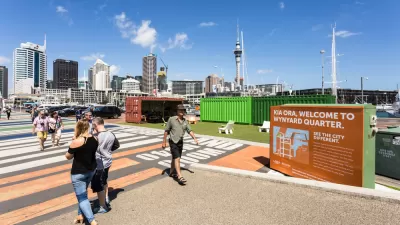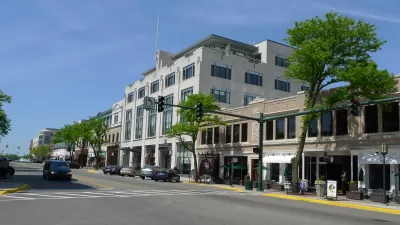There may be a way to supply some of the benefits of form-based codes without heavy-handed aesthetic regulation. In theory, a form-based code could be limited to verifiable characteristics such as setbacks, yard types, building height, frontage size and lot coverage.
In a forthcoming article, Nicole Garnett of Notre Dame Law School critiques form-based codes, on the reasonable ground that these codes often include meticulous aesthetic regulations that may be difficult and expensive to comply with.
However, there may be a way to supply some of the benefits of form-based codes without heavy-handed aesthetic regulation. In theory, a form-based code could be limited to verifiable characteristics such as setbacks, yard types, building height, frontage size and lot coverage.
On the positive side, a form-based code focusing on the sort of objective indicators traditionally regulated by zoning would allow a developer to build buildings that were at least somewhat compatible with the rest of a neighborhood (or with the city's vision of what a neighborhood should look like), without having to pay the costs of aesthetic regulation. For example, a city could mandate that all buildings in a neighborhood be small enough to create a dense, low-rise neighborhood, without telling the developer what the windows, facades or other architectural details should look like.
On the other hand, there may be a trade-off between flexibility and beauty: a zoning code that only addressed objective indicia of community character such as building height and width would allow the creation of buildings that on paper are compatible with a city's plan, and yet are poorly built and/or do not look particularly good.
But even such a permissive form-based code could be used to create neighborhoods that are no uglier than existing sprawl and are far more pedestrian-friendly. So for a city concerned about housing costs and burdening developers, a form-based code that does not regulate aesthetics might be an adequate compromise between a more rigorous form-based code and status quo zoning.

Americans May Be Stuck — But Why?
Americans are moving a lot less than they once did, and that is a problem. While Yoni Applebaum, in his highly-publicized article Stuck, gets the reasons badly wrong, it's still important to ask: why are we moving so much less than before?

Using Old Oil and Gas Wells for Green Energy Storage
Penn State researchers have found that repurposing abandoned oil and gas wells for geothermal-assisted compressed-air energy storage can boost efficiency, reduce environmental risks, and support clean energy and job transitions.

Placekeeping: Setting a New Precedent for City Planners
How a preservation-based approach to redevelopment and urban design can prevent displacement and honor legacy communities.

San Francisco’s Muni Ridership Grew in 2024
The system saw its highest ridership since before the Covid-19 pandemic, but faces a severe budget shortage in the coming year.

Colorado Lawmakers Move to Protect BRT Funding
In the face of potential federal funding cuts, CDOT leaders reasserted their commitment to planned bus rapid transit projects.

Safe Streets Funding in Jeopardy
The Trump administration is specifically targeting bike infrastructure and other road safety projects in its funding cuts.
Urban Design for Planners 1: Software Tools
This six-course series explores essential urban design concepts using open source software and equips planners with the tools they need to participate fully in the urban design process.
Planning for Universal Design
Learn the tools for implementing Universal Design in planning regulations.
Heyer Gruel & Associates PA
City of Moreno Valley
Institute for Housing and Urban Development Studies (IHS)
City of Grandview
Harvard GSD Executive Education
Salt Lake City
NYU Wagner Graduate School of Public Service
City of Cambridge, Maryland





























